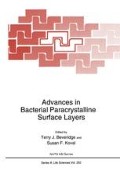Abstract
Members of the recently discovered archaeobacterial genus Pyrobaculum are sulfur-reducing hyperthermophiles which grow optimally at 100°C (Huber et al., 1987). All known strains were isolated from superheated, sulfurous fresh water springs or from the superheated outflow of a geothermal power plant. The cells are rod-shaped and vary in length up to 8µm, but their diameter is strikingly uniform. Two strains have been characterized in detail and were found to represent different species, Pyrobaculum islandicum (strain GEO3) and Pyrobaculum organotrophum (strain H10). P. islandicum is a facultative heterotroph capable of chemolithoautotrophic growth on sulfur, H2, and CO2, while P. organotrophum is strictly organotrophic. This Chapter reviews the results of investigations into the structure of the cell envelopes of these interesting archaeobacteria (Baumeister et al., 1989, 1990; Phipps et al., 1990, 1991). An element of the cell envelope of most archaeobacteria is a 2D paracrystalline array of protein or glycoprotein subunits, or S-layer, which is often directly adjacent to the cytoplasmic membrane (König, 1988). The array subunit is typically a complex, multi-domain protein and often possesses a putative membrane anchor domain (Baumeister et al., 1989). The unusual structures of Pyrobaculum S-layers are described, and the possible functional roles they fulfill are discussed.
Access this chapter
Tax calculation will be finalised at checkout
Purchases are for personal use only
Preview
Unable to display preview. Download preview PDF.
References
Baumeister, W., and Hegerl, R., 1986, Can S-layers make bacterial connexons?, FEMS Microbiol. Lett. 36: 119.
Baumeister, W., Wildhaber, I., and Phipps, B.M., 1989, Principles of organization in eubacterial and archaebacterial surface proteins, Can. J. Microbiol. 35: 215.
Baumeister, W., Lembcke, G., Dürr, R., and Phipps, B., 1990, Electron crystallography of bacterial surface proteins, in: “Electron Crystallography of Organic Molecules,” J.R. Fryer and D.L. Dorset, eds., Kluwer Academic Publishers, Amsterdam.
Huber, R., Kristjansson, J.K., and Stetter, KO., 1987, Pyrobaculum gen. nov., a new genus of neutrophilic, rod-shaped archaebacteria from continental sol-fataras growing optimally at 100°C, Arch. MicrobioL 149: 95.
König, H., 1988, Archaebacterial cell envelopes, Can. J. Microbiol. 34: 395.
Messner, P., Pum, D., Sara, M., Stetter, KO., and Sleytr, U.B., 1986, Ultra-structure of the cell envelope of the archaebacteria Thermoproteus tenax and Thermoproteus neutrophilus, J. BacterioL 166: 1046.
Phipps, B.M., Engelhardt, H., Huber, R., and Baumeister, W., 1990, Three-dimensional structure of the crystalline protein envelope layer of the hyperthermophilic archaebacterium Pyrobaculum islandicum, J. Struct. Biol. 103: 152.
Phipps, B.M., Huber, R., and Baumeister, W., 1991, The cell envelope of the hyperthermophilic archaebacterium Pyrobaculum organotrophum consists of two regularly arrayed protein layers: three-dimensional structure of the outer layer, Molec. MicrobioL 5: 253.
Saxton, W.O., and Baumeister, W., 1982, The correlation averaging of a regularly arranged bacterial cell envelope protein, J. Microsc. 127: 127.
Saxton, W.O., Baumeister, W., and Hahn, M., 1984, Three-dimensional reconstruction of imperfect two-dimensional crystals, Ultramicroscopy 13: 57.
Wildhaber, I., and Baumeister, W., 1987, The cell envelope of Thermoproteus tenax: three-dimensional structure of the surface layer and its role in shape maintenance, EMBO J. 6: 1475.
Author information
Authors and Affiliations
Editor information
Editors and Affiliations
Rights and permissions
Copyright information
© 1993 Springer Science+Business Media New York
About this chapter
Cite this chapter
Phipps, B.M. (1993). Structures of Paracrystalline Protein Layers from the Hyperthermophilic Archaeobacterium Pyrobaculum . In: Beveridge, T.J., Koval, S.F. (eds) Advances in Bacterial Paracrystalline Surface Layers. NATO ASI Series, vol 252. Springer, Boston, MA. https://doi.org/10.1007/978-1-4757-9032-0_3
Download citation
DOI: https://doi.org/10.1007/978-1-4757-9032-0_3
Publisher Name: Springer, Boston, MA
Print ISBN: 978-1-4757-9034-4
Online ISBN: 978-1-4757-9032-0
eBook Packages: Springer Book Archive

